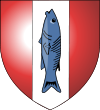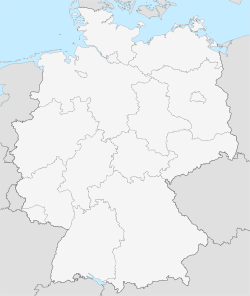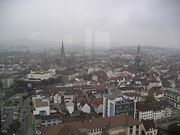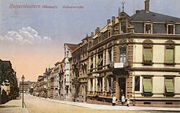Kaiserslautern
| Kaiserslautern | |
| Coat of arms | Location |
 |
 |
| Administration | |
| Country | Germany |
|---|---|
| State | Rhineland-Palatinate |
| District | Urban district |
| Town subdivisions | 18 districts with 22 suburbs |
| Lord Mayor | Klaus Weichel (SPD) |
| Basic statistics | |
| Area | 139.72 km² (53.9 sq mi) |
| Elevation | 245 m (804 ft) |
| Population | 98,044 (30/12/2006) |
| - Density | 702 /km² (1,817 /sq mi) |
| Other information | |
| Time zone | CET/CEST (UTC+1/+2) |
| Licence plate | KL |
| Postal codes | 67601–67663 |
| Area codes | 0631 / 06301 |
| Website | www.kaiserslautern.de |
Kaiserslautern (IPA: [kaɪzɐsˈlaʊtɐn]) is a city in southwest Germany, located in the Bundesland (State) of Rhineland-Palatinate (Rheinland-Pfalz) at the edge of the Palatinate forest (Pfälzer Wald). The historic centre dates to the 9th century and is within easy reach of Paris (459 kilometres) and Luxembourg (159 kilometres).
Kaiserslautern is home to 99,469 people. In the city and its surrounding district (Landkreis Kaiserslautern) live an additional approximately 50,000 NATO military personnel members (mainly American), who often call the city K-Town, and contribute approximately $1 billion annually to the Kaiserslautern economy. [2].
Contents |
History
Prehistoric settlement in the area of what is now Kaiserslautern has been traced to at least 800 B.C. Some 2,500-year-old Celtic tombs were uncovered at Miesau, a town about 29 kilometres west of Kaiserslautern. The recovered relics are now in the Museum for Palatinate History at Speyer.
Kaiserslautern received its name from the favourite hunting retreat of Holy Roman Emperor Frederick Barbarossa who ruled the Holy Roman Empire from 1155 until 1190. The small river Lauter made the old section of Kaiserslautern an island in medieval times. Ruins of Frederick's original castle, built 1152–1160, can still be seen in front of the Rathaus (city hall). A second castle, Nanstein Castle, was built at Landstuhl to guard the western approach to the city. Because of the influence Frederick Barbarossa had on the town, it is nicknamed a "Barbarossa town".
The Stiftkirche, Kaiserslautern's oldest church, was constructed in 1250–1350. As the population of Kaiserslautern grew, King Rudolf von Habsburg chartered the town in 1276. St. Martin's Kirche (church) was built from 1300–1350 for an order of monks. Today a section of the original city wall still stands in the courtyard of the church.
In 1375, the city of Kaiserslautern was put into pawn to the Kurpfalz and therefore became subsequently part of the Wittelsbach heirloom. In 1519, Franz von Sickingen became the owner of Nanstein Castle. He became a Protestant, and in 1522 Nanstein was a stronghold for local nobles favouring the Reformation. Sickingen and the local nobles began their battle against the Archbishop of Trier; but the attack was unsuccessful, and they retreated to Nanstein. Nanstein was then besieged by cannon-armed German Catholic princes. Sickingen died after the castle surrendered, and the Protestant nobility of the Palatinate were subdued by the Catholic princes.
Count of the Palatinate Johann Casimir, came to Kaiserslautern during the Thirty Years' War (1618–1648). Harsh Spanish occupation in 1621–1632 ended when Protestant Swedish armies liberated the area. In 1635, however, the ruthless Croatian troops of the Austrian emperor's army entered Kaiserslautern and killed 3,000 of the 3,200 residents in three days' plundering. Landstuhl was saved from a similar fate by surrendering without a fight. It took Kaiserslautern about 160 years to repopulate itself.
Conflict did not end with the Peace of Westphalia in 1648. The Elector of the Pfalz had difficulty with many of his subjects and ordered all castles, including Nanstein, destroyed. The French repeatedly invaded and occupied the area, residing in Kaiserslautern in 1686–1697. Nevertheless, after the treaty of Utrecht it was restored to be part of the Palatinate. During the unquiet episodes in the 18th century, the Palatinate was the scene of fighting between French and German troops of different states. In 1713, the French destroyed Barbarossa's castle and the city's wall towers. From 1793 until Napoleon's defeat at Waterloo in 1815, the area was under French administration.
As French power declined after 1815, Kaiserslautern and the Palatinate became a Bavarian province and remained so until 1918. After World War I, French troops again occupied the Palatinate for several years.
In World War II, more than 60% of Kaiserslautern was destroyed by bombs from Allied aircraft. The railway and several main roads were primary targets. The heaviest attacks occurred on 7 January, 11 August, and 28 September, 1944. Of the 20,000 homes, 11,000 were destroyed or damaged. The cemetery wall opposite Kleber Kaserne still bears shell marks of these raids.
On 20 March, 1945, as the last of Omar Bradley's 1st Army crossed the Rhine at Remagen, the U.S. 80th Division, 319th Infantry, part of George Patton's 3rd Army, seized Kaiserslautern without resistance. The war was over for this area, but there was little reconstruction until the currency reform of 1948. The pace of the economy remained slow until 1952, when construction for newly established garrisons of American troops brought economic growth to the area.
The city's coat of arms is a red and white shield, with an open-mouthed pike on it. This was reportedly Frederick's favorite dish.
Sites and buildings
Today, Kaiserslautern is a modern centre of information and communications technology as well as a well-known university, a technical college and many international research institutes located throughout the city.
The Palatine Gallery dates from 1874 featuring exhibits of painting and sculpture from the 19th century to the present day.

Town Hall Kaiserslautern is one of the tallest buildings and is located in the city centre. The bar and coffee shop on the top floor provides a paranoramic view of the city and surrounding countryside.
The tallest building in the center of Kaiserslautern is Marienkirche, a Catholic church.
The television tower, in fact the highest structure in Kaiserslautern is not in the city centre, but located at Dansenberg, a suburb in the southwest of the city.
Kaiserslautern's large botanical gardens feature a Japanese-style garden. Another unusual feature is the Waschmühle, an enormous 160-metre public swimming pool that is the largest in Europe. There are several pedestrian only shopping zones with numerous and varied restaurants and bars located in the city centre surrounding the old city (Altstadt). In the Altstadt you will find the "Kaiserbrunnen", a large ornamental fountain in which various historically important features of the city are represented, including eg. a sewing machine - for the Pfaff-werke, a football, and various creatures, on which children can climb.
University of Kaiserslautern
University of Kaiserslautern was founded on 13 July 1970. Earlier, it was part of the twin University Trier/Kaiserslautern. It started with the departments of Mathematics, Physics and Technology. Later many more facilities were added.
Culture and Sports

Pfalztheater Kaiserslautern Local theatre Pfalztheater employs more than 300 people and features plays, operas, ballets, concerts, and musicals. The first German performance of West Side Story took place there. As the arts in Germany are significantly subsidized by the government, its ticket prices are reasonably low. Pfalztheater Kaiserslautern hosts the Else-Lasker-Schüler-Preis awards for German literature.
The Kammgarn The Kammgarn is classified as a historical site. It served as a spinning factory before being transformed into the cultural heart of Kaiserslautern. This renovation has preserved its historical character while incorporating the latest sound and lighting technologies. The Kammgarn stands among the top venues in Germany and serves as a first-call club for rising groups and performers as well as established jazz, rock, blues and pop artists in Europe. Performances have included international stars B.B. King, Manfred Mann's Earth Band, Pat Metheny, Uriah Heep and Jan Garbarek.
Gartenschau (Garden exhibition) Better known as the 'Dino Park' because of its lifesize dinosaur models, the Gartenschau is open from April through October and is popular with families. Having begun as a series of botanical displays and enjoying success at the first State Garden Exhibition of Rhineland-Palatinate in Kaiserlautern in 2000, this 54-acre (220,000 m2) park has been transformed into one of the most multi-dimensional cultural centers in Germany.
Fritz Walter Stadium The newly renovated Fritz Walter Stadion accommodates 48,500 football fans. In June 2006, Kaiserslautern was one of 12 German cities to host the 2006 FIFA World Cup. During the five matches played, the first goal ever from an Australian team in a Football World Cup finals match was scored (By Tim Cahill).
Kaiserslautern is also home to the Football team 1. FC Kaiserslautern, which achieved the title "Deutscher Meister" (German champions) four times.
Museums and libraries
- Palatinate Gallery of Art Pfalzgalerie (artgallery, mainly pictures and sculptures from the 19th and 20th century)
- Wadgasserhof/ Theodor-Zink-Museum (local history)
- Stadtbibliothek (Municipal Library)
- Universitätsbibliothek (university library of Kaiserslautern)
- Hochschulbibliothek (Bibliothek of Fachhochschule)
- Pfalzbibliothek (scientific library with a main focus on palatinate issues)
Religion
Churches
The largest church is the Mary Church. There is also the historic Apostel Church.
Mosques
The city has two mosques. The first mosque was built by the Turkish community living in the city. It is located on the Richard-Wagner-Str. Another one built more recently, Islamic Centre Kaiserslautern, is located at Humboldstraße.
Synagogue
The city was once the site of the magnificent Moorish Revival Kaiserslautern synagogue. Built in 1886, the synagogue's great dome could be seen from across the city. It was destroyed on Kristallnacht.[1]
Nature

Kaiserslautern is located in Germany's largest forest area (Palatinate forest) and offers numerous hiking trails and lakes to visitors.
Other places of interest in Kaiserslautern are:
- Humbergturm, an observation tower, built in 1900, offering a great view over the Palatinate Forest
- Kaiserslautern Zoo at Siegelbach
- Karlstal (a whitewater canyon)
- Kaiserpfalz, the castle of emperor Barbarossa (Redbeard)
- Burg Nanstein, Landstuhl, a castle in the district
- Burg Hohenecken, a castle in a suburb/ward of Kaiserslautern
- Gartenschau, a horticultural show, including the largest dinosaur show of Europe
- Japanischer Garten (Japanese Garden), largest garden of its kind in Europe.
Climate
Average Temperatures:
| Month | Jan | Feb | Mar | Apr | May | Jun | Jul | Aug | Sep | Oct | Nov | Dec |
| max. | 04°C | 05°C | 10°C | 13°C | 19°C | 22°C | 25°C | 25°C | 20°C | 15°C | 09°C | 05°C |
| min. | -1°C | -2°C | 02°C | 03°C | 08°C | 12°C | 14°C | 13°C | 09°C | 06°C | 03°C | 01°C |
Sister cities
|
|
|
|
Business
Companies in Kaiserslautern
- ACO Guss GmbH (was Guss und Armaturwerk Kaiserslautern; steel)
- Adam Opel GmbH (car factory]
- F.K. Horn GmbH & Co. KG (construction)
- Bahntechnik Kaiserslautern (formerly Bundesbahn-Ausbesserungswerk; trains and wagons)
- Corning GmbH (catalytic converters)
- CP Schmidt Verpackungswerk GmbH & Co. KG (cardboard and wrappings)
- Euromaster GmbH (tires, company headquarters)
- FACT Future Advanced Composites & Technology GmbH (plastics)
- Freudenberg Vliesstoffe KG (manufacturer of fibrous webs)
- Fruit of the Loom GmbH (European center for logistics)
- Gebr. Pfeiffer AG (stonemills)
- GENERAL DYNAMICS Santa Bárbara Sistemas GmbH (until 2002 Eisenwerke Kaiserslautern; amphibious vehicles, mobile bridges for military use)
- Hochwald Nahrungsmittel-Werke GmbH (milk)
- Human Solutions GmbH (hardware/software for ergonomic processes and bodyscanners)
- Keiper GmbH & Co. KG (carseats)
- Linux Networx GmbH (headquarters for Europe, specialists for supercomputer)
- LMS Deutschland GmbH (software development for mechanic, structural density and components)
- Lumera Laser GmbH (laser systems)
- Market Maker Software AG (software for stock portfolio management)
- maxess Systemhaus GmbH (IT solutions for grocery companies)
- MOBOTIX AG (network cameras and surveillance systems)
- Pfaff Industrie Maschinen AG (sewing machines)
- Rohr Druck GmbH (printing)
- Saar-Pfalz Erfrischungsgetränke GmbH & Co. KG (licensee of Coca-Cola)
- SIEDA Systemhaus für intelligente EDV-Anwendungen GmbH (software for hospitals, scheduling, and logistics)
- Spinnerei Lampertsmühle GmbH (textiles)
- Talia (formerly Gondrom; bookstores)
- Torpedo-Garage GmbH & Co. KG (branch of Daimler-Chrysler AG)
- Wipotec Wägetechnik GmbH (scales)
- Albert Ziegler GmbH & Co. KG (fire-fighting equipment)
- ALPLA
US Military
Between 1950 and 1955, Kaiserslautern developed into the largest US military community outside of the United States. For this reason Kaiserslautern, somewhat to the chagrin of native German residents, is also referred to as "K-town"; a term coined by the early American military population who had difficulty pronouncing the name. The Kaiserslautern Military Community (KMC) is a combined community consisting of Army and Air Force components. The KMC consists of Army facilities at Kleber, Panzer, and Daener Kaserne, Landstuhl, Miesau, Einsiedlerhof, Pirmasens, Rhine Ordnance and Pulaski Barracks along with Air Force facilities located at Ramstein Air Base, Sembach, Vogelweh, and Kapaun Air Station.
References
External links
- Official website
- History of Kaiserslautern
- Kammgarn Nightclub
- K-Town Review - Website dedicated to good food, bars, and links for the "K-town" area
|
|
Important cities and tourist sites in Germany: Area of Heidelberg / Rhine-Neckar |
|
||||||||
|---|---|---|---|---|---|---|---|---|---|---|
|
||||||||||
|
||||||||